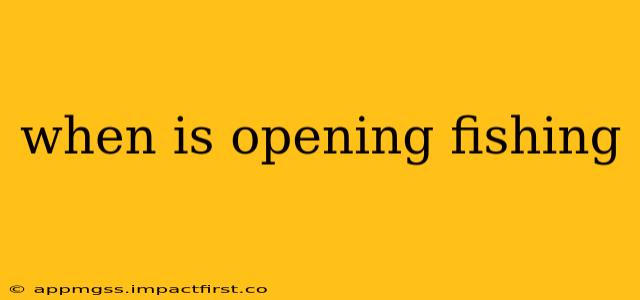When is Opening Day for Fishing? A Comprehensive Guide
The question "When is opening fishing?" is deceptively simple. The answer, unfortunately, isn't a single date. Opening day for fishing varies dramatically depending on location, species, and specific regulations. This guide will help you understand the complexities and find the information you need to legally and responsibly enjoy your fishing trip.
What Determines Fishing Season Opening Dates?
Several factors influence when fishing seasons open:
-
Species: Different fish species have different spawning seasons and growth cycles. Protecting these species requires tailored opening dates to ensure their populations remain healthy. Trout, for example, often have earlier opening dates than bass, reflecting their different life cycles.
-
Geographic Location: Climate, water temperature, and the specific fish populations in a given area all play a role. A lake in northern Canada will have a much later opening date than a lake in Florida, due to vastly different water temperatures. Even within a single state, different bodies of water can have unique opening dates.
-
Conservation Efforts: Fisheries management agencies carefully monitor fish populations and adjust opening dates to protect vulnerable species. Overfishing can severely impact ecosystems, so these regulations are crucial for long-term sustainability.
-
Local Regulations: Each state, province, or territory establishes its own fishing regulations. These regulations are often further broken down by county or even specific bodies of water. It's crucial to check with the relevant authorities for the most up-to-date information.
How to Find Your Local Fishing Season Opening Dates
Finding the precise opening day for fishing in your area requires some research. Here's a step-by-step guide:
-
Identify your location: Be specific! Note the state, county, and even the specific lake or river you plan to fish.
-
Locate your relevant fisheries agency: This is typically a state or provincial wildlife agency, or a similar governmental body. A quick online search for "[Your State/Province] fishing regulations" will usually lead you to the correct website.
-
Check their online resources: Most agencies have websites with detailed fishing regulations, often including interactive maps showing specific opening dates for different waters and species.
-
Look for a fishing license: Purchasing a fishing license usually involves agreeing to abide by the regulations. The license purchasing process itself can often link you to the regulations.
-
Consult local fishing shops or guides: Local experts are valuable resources. They'll often have the most up-to-date information on local fishing conditions and regulations.
What are the common species of fish?
The "common" species vary significantly by region. Some widely popular species include:
- Trout: Rainbow trout, brown trout, brook trout
- Bass: Largemouth bass, smallmouth bass, spotted bass
- Salmon: Chinook salmon, coho salmon, Atlantic salmon
- Catfish: Channel catfish, blue catfish
- Walleye: A popular freshwater game fish.
Remember, always respect the regulations. Illegal fishing activities not only harm fish populations but can also result in fines and other penalties.
What are some common fishing regulations?
Fishing regulations vary widely, but common rules include:
- Size limits: Minimum and maximum sizes of fish you can keep.
- Bag limits: The maximum number of fish you can catch and keep in a day.
- Gear restrictions: Types of bait, hooks, and tackle allowed.
- Closed seasons: Periods when fishing for a specific species is prohibited.
This information is for general guidance only. Always consult the official regulations for your specific location and intended fishing activities. Enjoy your fishing trip!
